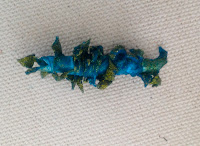The November meeting of the Fibre Optics Group began with another warm up collage. As we have mentioned before, we are focussing on a design principle or element at the beginning of each meeting. We then start the clock and have only a half hour to produce a collage illustrating the principle/element chosen for the month.We have a tub full of various supplies, and these are the only things we are allowed to use to make our collage.
 |
| Half Hour Collages |
In November, Judi presented the design principle/element of LINE. Line is defined as “a mark, long in it’s proportion to its breadth, made on a surface with a pen, pencil, tool, etc.” Line is often referred to the “the most basic element of design”, yet it functions in complex ways and can express a variety of verbal and visual concepts.
Here is a photo of our collages. It is easy to see that we all have different styles in our approach and resulting collages.
 |
| UTEE embellishments and shrink plastic embellishments |
After this, we were ready to start our play time. We were working with Melt Art™ Ultra Thick Embossing Enamel™. We dipped or sprinkled, then heated with a heat gun. We melted it in a Ranger’s Melting Pot®, and then poured, dipped and let it dry. We stamped into it, poured it onto stamps, and anything else we could think of to try. As you will see from the photos, we did some amazing things that day.
 |
| Shrink Plastic flower formed with a heat gun |
You can also use the melting pot to shrink your Shrink Art Plastic. Everyone had at least one sheet of Grafix™ Shrink Film to try.
I brought along my Sissix™ Big Shot machine and some dies, so that added another dimension. Cutting out a large flower from the shrink film, colouring it with ink, felt pen, or even pencil crayons and then shrinking it with the heat gun was the start. We soon learned that we could manipulate the petals while they were hot. This pliability does not last long, but we determined you could re-heat it if necessary. Yet another interesting discovery!
I also wanted to leave you with a snapshot of a few of us busy working at our tables. We are messy, but Creative!



















